Bridge Crane 5 Ton for Sale Saudi Arabia, Low Headroom Bridge Crane
Bridge Crane 5 Ton for Sale Saudi Arabia, Low Headroom Bridge Crane. 5 ton bridge crane for sale Saudi Arabia. Custom bridge crane 5 ton, low headroom design for sale, GOOD price, 380V. Get your bridge crane 5 ton design !
Overview of 5 ton crane for sale Saudi Arabia
- Crane type: low headroom bridge crane 5 ton
- Crane specification: 5T-3.06M H3.5M
- Crane power supply: 380V60HZ3P
- Project location: Saudi Arabia
Case Study: Providing Low Headroom Bridge Crane Solution for Saudi Arabia
Client Information:
- Location: Riyadh, Saudi Arabia
- Industry: Manufacturing and Heavy Equipment
- Requirement: A 5-ton bridge crane with a low headroom design
Background and lifting requirements of bridge crane 5 ton :
The client's Industries, a prominent player in the manufacturing industry in Saudi Arabia, specializes in producing heavy machinery components. With an ever-growing demand for their products, client's Industries identified the need to optimize their production process by upgrading their material handling equipment. In particular, they required a bridge crane that could efficiently lift heavy components while operating within their limited vertical workspace.
The main challenge was the limited headroom available in client's Industries' manufacturing facility. Traditional bridge cranes have a higher profile that could result in collisions with the facility's overhead structures, hindering smooth operations and potentially damaging valuable equipment. To maximize the utilization of the available space and prevent any disruptions to production, client's Industries required a low headroom bridge crane solution.
What is headroom and low headroom crane design ?
The headroom of an overhead crane refers to the vertical distance between the highest point of the load lifting mechanism (usually the hook) and the lowest point of the crane's structure, such as the bottom of the bridge girder. In other words, it's the clearance space needed above the load for the crane to operate safely and without any obstructions.
Headroom is a critical factor to consider when designing or selecting an overhead crane for a specific application. It ensures that the crane can lift and maneuver loads without interference from the ceiling, beams, lights, or any other obstacles in the facility. Insufficient headroom can lead to collisions, damage to equipment, or unsafe working conditions.
In cases where there are space limitations, such as in low-ceilinged buildings or areas with limited vertical clearance, low headroom cranes are designed and used. These cranes are engineered with a compact profile to minimize the required headroom while maintaining the crane's lifting capacity and functionality. The design of low headroom cranes aims to optimize the use of available vertical space while adhering to safety standards.
Low Headroom Bridge Crane Design Solution
After a thorough assessment of client's Industries' requirements and the constraints of their facility, our engineering team recommended a custom-designed low headroom bridge crane. The key features of the proposed solution were:
The crane was designed with a low headroom profile to ensure that it could operate smoothly within the limited vertical clearance of the facility. This design element eliminated the risk of collisions with overhead structures and provided unobstructed movement for the crane.
A low headroom bridge crane design is specifically engineered to minimize the vertical space required for the crane to operate effectively. This design is crucial for facilities with limited overhead clearance, ensuring that the crane can lift and move loads while avoiding collisions with the ceiling or other obstacles. Here are some key characteristics and design considerations for a low headroom bridge crane:
- 1. Compact Profile: The most distinctive feature of a low headroom bridge crane is its compact profile. The components of the crane, such as the bridge girder, hoist, and trolley, are designed to have reduced heights while maintaining their structural integrity and lifting capacity.
- 2. Shortened End Trucks: End trucks are the components at the ends of the bridge girder that facilitate movement along the runway. In a low headroom design, these end trucks are engineered to have a reduced height, allowing the crane to operate in confined spaces.
- 3. Raised Hoist Configuration: In some low headroom bridge crane designs, the hoist unit is positioned higher up on the bridge girder. This design choice provides more vertical space beneath the hoist and hook, allowing for greater clearance when lifting loads.
- 4. Slim Trolley Design: The trolley, which moves horizontally along the bridge girder, may have a slimmer profile in a low headroom design. This helps optimize the space between the trolley and the load, further reducing the risk of collisions.
- 5. Recessed Hook Block: Some low headroom cranes incorporate a recessed hook block or hoist drum, which is designed to minimize the distance between the hook and the structure above it. This design reduces the required headroom and provides more clearance for lifting operations.
- 6. Precision Engineering: Low headroom crane designs require meticulous engineering to ensure that the crane remains stable, safe, and capable of handling the specified load capacity. Structural calculations and material selection are critical to maintain the crane's integrity.
- 7. Smooth Operation: Despite the reduced headroom, a well-designed low headroom crane should maintain smooth and precise movement. This includes features like fine-tuned controls, minimal sway during load movement, and optimal acceleration and deceleration rates.
- 8. Compliance with Standards: Low headroom bridge cranes, like any other type of crane, must adhere to industry safety standards and regulations. Compliance ensures the crane's safe operation and the well-being of workers in the facility.
- 9. Customization: Each facility's space limitations are unique, so low headroom crane designs often require customization. Engineering teams work closely with clients to understand their specific needs and design cranes that fit seamlessly within the available vertical clearance.
- 10. Installation and Maintenance: Proper installation and ongoing maintenance are crucial for the performance and longevity of a low headroom bridge crane. Regular inspections and servicing ensure that the crane remains safe and efficient over its operational life.
In summary, a low headroom bridge crane design is a specialized solution for facilities with limited overhead space. Its compact profile and carefully engineered components allow for safe and efficient material handling while minimizing the risk of collisions and obstructions.
With a span of 3.06 meters and a height of 3.5 meters, the crane's dimensions were customized to match the layout and space available in client's Industries' facility. This ensured optimal coverage and effective material handling without compromising the facility's operational space.
To cater to the Saudi Arabian power standards, the crane was configured to operate on a 380V, 60Hz, 3-phase power supply, ensuring consistent and reliable performance.
Main parts and components of bridge crane 5 ton for sale Saudi Arabia
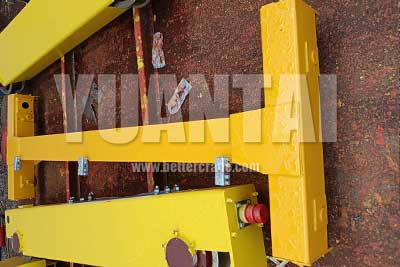
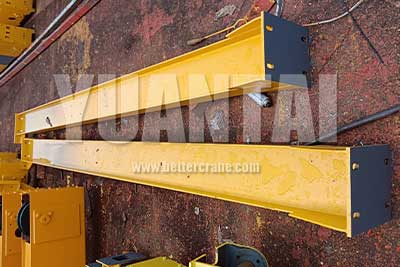
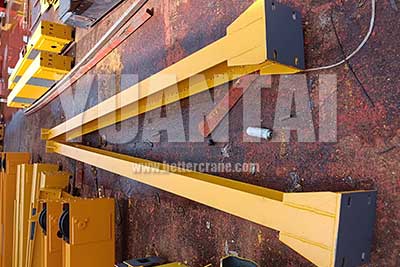
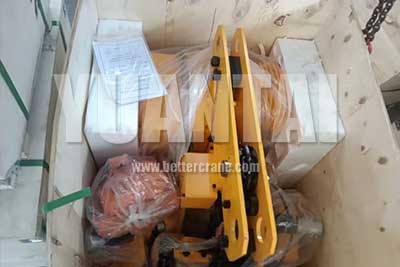

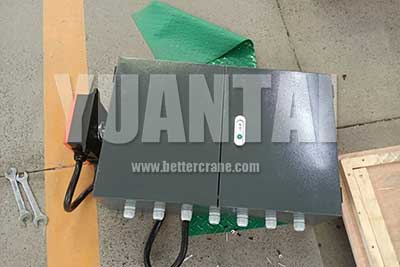
The low headroom bridge crane with a 5-ton lifting capacity was successfully installed at client's Industries' manufacturing facility in Riyadh, Saudi Arabia. The custom design addressed the headroom limitations of the facility, enabling smooth and efficient material handling operations. This solution significantly contributed to optimizing their production process, reducing downtime, and enhancing overall operational efficiency.
By providing a tailor-made low headroom bridge crane solution that aligned with client's Industries' requirements, we demonstrated our commitment to delivering innovative and efficient material handling solutions. The successful implementation of the crane not only addressed the client's immediate needs but also positioned them for enhanced productivity and growth in the competitive manufacturing landscape of Saudi Arabia.




